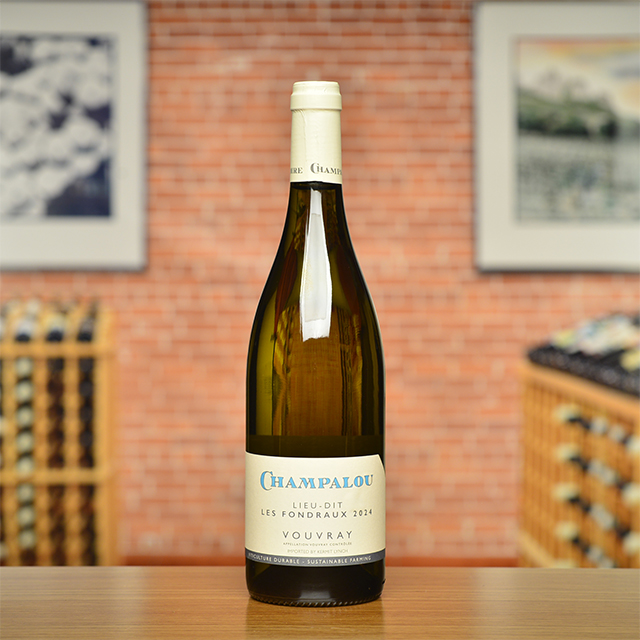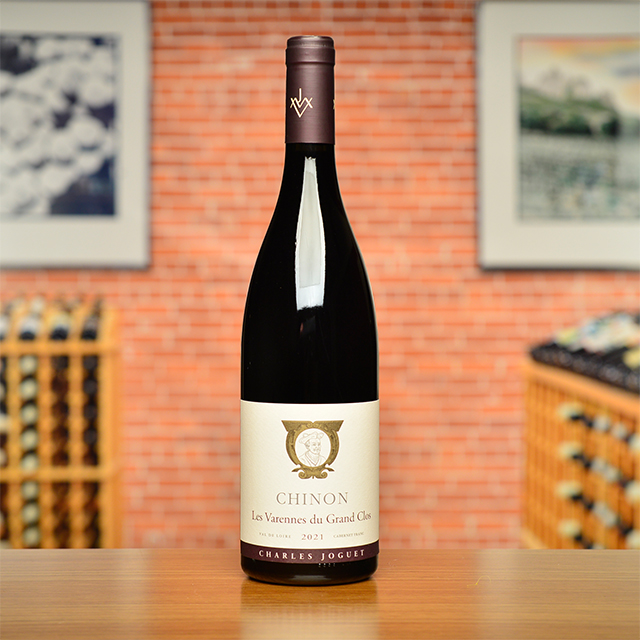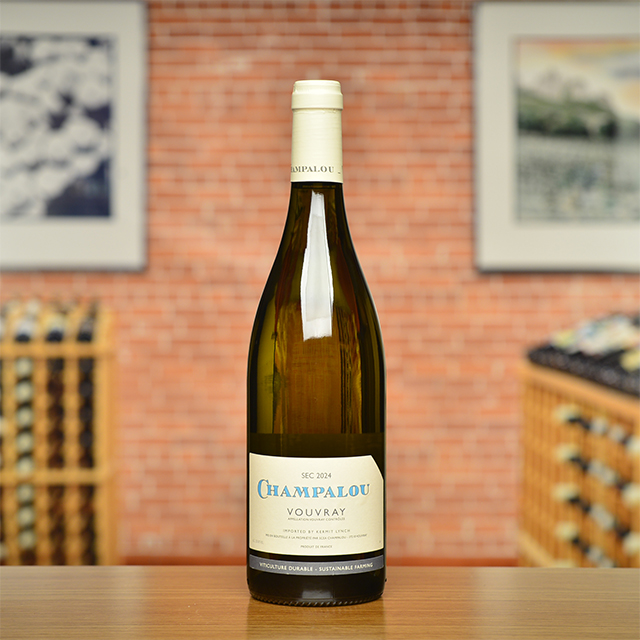Notify me
Vouvray Brut
Champalou
The Champalou family—Catherine, Didier, and their daughter, Céline—are Chenin Blanc specialists: from the vineyards around their home in the heart of the Vouvray appellation, they make wines in every style from the noble Pineau de la Loire, as the grape is also known. Their Vouvray pétillant is crafted in the méthode traditionelle: the secondary fermentation takes place in bottle, and then the wine is aged extensively on its lees—in this case, two years—before being disgorged and recorked. From clay and limestone vineyards, they are able to obtain remarkable complexity in their Brut, while the texture shows both a creamy richness and an austere minerality. For this reason, this wine makes a great bargain alternative to Champagne, but it is important not to overlook the fact that it comes from a terroir and grape variety of its own. The Champalous like to serve it at the end of a meal, but this dry sparkler works well from the apéritif all the way through dessert.
—Anthony Lynch
| Wine Type: | sparkling |
| Vintage: | NV |
| Bottle Size: | 750mL |
| Blend: | Chenin Blanc |
| Appellation: | Vouvray |
| Country: | France |
| Region: | Loire |
| Producer: | Champalou |
| Winemaker: | Catherine & Didier Champalou |
| Vineyard: | 20 years average, 3.5 ha |
| Soil: | Clay, Limestone |
| Farming: | Sustainable |
| Alcohol: | 13% |
More from this Producer or Region

2024 Quincy
France | Loire
You’ll appreciate the distinctive flavor profile: born from warmer soils, it tastes of ripe, succulent citrus devoid of grassiness, while boasting the same flinty nerve as a good Sancerre.

2022 Chinon Blanc
France | Loire
Ultra fresh and brimming with citrus blossom and orchard fruit notes, it has a saline, mineral finish that leaves my palate begging for more.

2024 Vouvray “Les Fondraux”
France | Loire
The contrast of ripe, succulent Chenin Blanc fruit with a spike of flinty minerality is like licking honey off an arrowhead.

Vouvray Brut
France | Loire
Made from Chenin Blanc in the Champagne method, this cuvée is the quintessential apéritif sparkling wine, with notes of apple and pear and a fine bead.

2021 Vin de France Blanc “Chenin Centenaire”
France | Loire
Fermented and aged in barrel and bottled unfiltered, it features a delightful kiss of oak on the long, bracing, mouth-watering finish.

2022 Saumur Champigny “Terres Chaudes”
France | Loire
Thierry has perfected the art of coaxing this Cabernet Franc’s soulfulness and elusive finesse into bottle.

2022 Quincy “Château de Quincy”
France | Loire
Textured, lush, full of aromatic gooseberry and passionfruit—all supported by spiny minerality.

2021 Chinon “Les Varennes du Grand Clos”
France | Loire
With floral aromas and fine-grained tannins, it already showcases its charms.

Chotard’s Best-In-Class Sancerres
France | Loire
These 2023s will take you on a journey several decades back to the old days of Sancerre.

2024 Vouvray
France | Loire
Gentle and refreshing on the palate, it boasts a delightful balance of stony minerality with luscious, almost honeyed fruit and flowery notes.
About The Producer
Champalou
About The Region
Loire

The defining feature of the Loire Valley, not surprisingly, is the Loire River. As the longest river in France, spanning more than 600 miles, this river connects seemingly disparate wine regions. Why else would Sancerre, with its Kimmeridgian limestone terroir be connected to Muscadet, an appellation that is 250 miles away?
Secondary in relevance to the historical, climatic, environmental, and cultural importance of the river are the wines and châteaux of the Jardin de la France. The kings and nobility of France built many hundreds of châteaux in the Loire but wine preceded the arrival of the noblesse and has since out-lived them as well.
Diversity abounds in the Loire. The aforementioned Kimmeridgian limestone of Sancerre is also found in Chablis. Chinon, Bourgueil, and Saumur boast the presence of tuffeau, a type of limestone unique to the Loire that has a yellowish tinge and a chalky texture. Savennières has schist, while Muscadet has volcanic, granite, and serpentinite based soils. In addition to geologic diversity, many, grape varieties are grown there too: Cabernet Franc, Chenin Blanc, Sauvignon Blanc, and Melon de Bourgogne are most prevalent, but (to name a few) Pinot Gris, Grolleau, Pinot Noir, Pineau d’Aunis, and Folle Blanche are also planted. These myriad of viticultural influences leads to the high quality production of every type of wine: red, white, rosé, sparkling, and dessert.
Like the Rhône and Provence, some of Kermit’s first imports came from the Loire, most notably the wines of Charles Joguet and Château d’Epiré—two producers who are featured in Kermit’s book Adventures on the Wine Route and with whom we still work today.
More from Loire or France
2024 Vouvray
Champalou France | Loire
2021 Bourgueil “La Dilettante”
Catherine & Pierre Breton France | Loire
2020 Saumur Champigny “Clos de l’Échelier”
Thierry Germain France | Loire
2023 Savennières
Château d’Epiré France | Loire
2021 Chinon “La Croix Boissée”
Bernard Baudry France | Loire
2024 Muscadet Sèvre et Maine Sur Lie
Domaine Michel Brégeon France | Loire
2022 Muscadet Sèvre et Maine “Réserve”
Domaine Michel Brégeon France | Loire
2023 Sancerre “Racines”
Daniel Chotard France | Loire
Vouvray Brut
Champalou France | Loire
2024 Pouilly-Fumé “Vieilles Vignes”
Régis Minet France | Loire
2022 Jasnières “Dyane”
Christine de Mianville France | Loire
2023 Chinon “Beaux Monts”
Catherine & Pierre Breton France | Loire
2024 Vouvray
Champalou France | Loire
2021 Bourgueil “La Dilettante”
Catherine & Pierre Breton France | Loire
2020 Saumur Champigny “Clos de l’Échelier”
Thierry Germain France | Loire
2023 Savennières
Château d’Epiré France | Loire
2021 Chinon “La Croix Boissée”
Bernard Baudry France | Loire
2024 Muscadet Sèvre et Maine Sur Lie
Domaine Michel Brégeon France | Loire
2022 Muscadet Sèvre et Maine “Réserve”
Domaine Michel Brégeon France | Loire
2023 Sancerre “Racines”
Daniel Chotard France | Loire
Vouvray Brut
Champalou France | Loire
2024 Pouilly-Fumé “Vieilles Vignes”
Régis Minet France | Loire
2022 Jasnières “Dyane”
Christine de Mianville France | Loire
2023 Chinon “Beaux Monts”
Catherine & Pierre Breton France | Loire
Kermit once said...

Kermit once said...
Let the brett nerds retire into protective bubbles, and whenever they thirst for wine it can be passed in to them through a sterile filter. Those of us on the outside can continue to enjoy complex, natural, living wines.
Inspiring Thirst, page 236
















